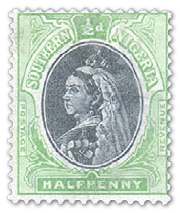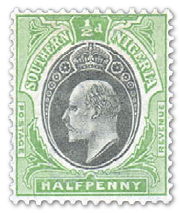If it is possible for a general collector of Great Britain and Colonies to give preference to the stamps of any particular Colony over the stamps of the other Colonies, then my choice would fall on Southern Nigeria. But before I give you the reasons for my choice, I wish to make it clear that my remarks are intended chiefly to relate to the stamps issued by that Colony during the 20th century, commencing with the first issue under the new designation of Southern Nigeria, as distinct from the Niger Coast Protectorate, and that I am not attempting to compare these stamps with the older issues of the other Colonies, which have a charm and attractiveness, which is distinctly their own, and which we cannot hope to surpass or even approach in the stamps of the present day.
I give preference to the stamps of Southern Nigeria because of the excellence of their design, a design, which is separate and distinct from the design adopted by any other Colony.
At the time when these stamps were issued some of the Colonies were suffering, from a philatelic point of view (as they are still now) from what may be described as a monotony of design, namely that of the Gold Coast type, where the main colour of the stamps up to the shilling value was purple, with a variation of colour for the name of the Colony and the value of the stamp, this type of stamp being adopted by at least seven of the Colonies, and also by Trinidad and Lagos as regards colour, but with a modification of design, and except that Lagos issued the 2 ½ d. design in blue. I was not myself a stamp collector at the time, but I should imagine that the first issue of Southern Nigeria bearing the portrait of the late Queen Victoria, came to the stamp collector as a very welcome change from the gold Coast type of that period.
The first two issues of Southern Nigeria. Left: 1901 Halfpenny yellow-green and black Queen Victoria. Right: 1903-04 Halfpenny yellow-green and black Edward VII
Even if we go back to the period when the title of the Colony was changed from Oil Rivers Protectorate to Niger Coast Protectorate, we find a most attractive set of stamp had been prepared, but, unfortunately, owing to the change in 1893, in the designation of the Colony from Oil Rivers Protectorate to Niger Coast Protectorate, and to save time in engraving the new dies, the words “Oil Rivers” had to be lined over, and the words “Niger Coast” added in black letters across the upper edge of the stamps of that issue, which somewhat marred their beauty. This defect was, however, removed by the issues of 1894 and 1897, and these issues, in my opinion, stand out as some of the most beautiful examples of the modern art of stamp production as applied to British stamps.
But to return to the first issue of Southern Nigeria, the design, though not perhaps so striking as the last issues of the Niger Coast Protectorate, is nevertheless a very pleasant one, and it has an attraction about it that immediately appeals to one as being something far in advance of most of the last issues of the Victorian issues.
This issue had a life of only eighteen months, when it was superseded in 1902 by the issue of stamps of the same attractive design, but bearing the head of King Edward VII, with single CA watermark, and these in turn were superseded by a change to paper watermarked multiple CA.
The only drawback to the stamp of Southern Nigeria appears to me to be, from a pecuniary point of view, the various changes having followed each other with such rapidity that many of the values have become very scarce.
Southern Nigeria is up to the present entirely free from surcharges, which I do not consider lend attractiveness to the stamps of any country. Now that Southern Nigeria has come into line with the other Colonies in adopting the colour scheme, we may expect some of the stamps of that Colony to lose some of their attractiveness, as a unicoloured stamp can never equal a bicoloured stamp for appearance.
Taking Southern Nigeria on its merits as a stamp issuing country, I think you will agree with me that it is a very desirable country to collect. It is a coming country of great promise. Its stamps are handsome, and have a most pleasing appearance in any collection. They are of solid and increasing value, and there are no surcharges, and these are my chief reasons for collecting Southern Nigeria.









This article is an added motivation to my quest for collecting pre-independence stamps of Nigeria especially those of Southern Nigeria. Thank you for bringing it up again after so many years. Happy collection.
Regards.
EDET AKPAN,
VICE PRESIDENT,
NIGERIA PHILATELIC CLUB,
CALABAR CHAPTER,
P.O.BOX 3542, CALABAR,
CROSS RIVERS STATE, NIGERIA. 540001
For added historical information on Southern Nigeria, visit http://www.earthrights.net/nigeria/history.html.
[…] LINKS Map from Sandafayre Stamp Atlas Philatelic Database on the Stamps of Southern Nigeria […]
For more information on the Southern Nigeria Protectorate, visit: http://en.wikipedia.org/wiki/Southern_Nigeria_Protectorate.
For an interesting article on the Royal Niger Company, visit: http://en.wikipedia.org/wiki/Royal_Niger_Company.
If you are a collector of Nigeria or West Africa, why not share your interests with our readers?